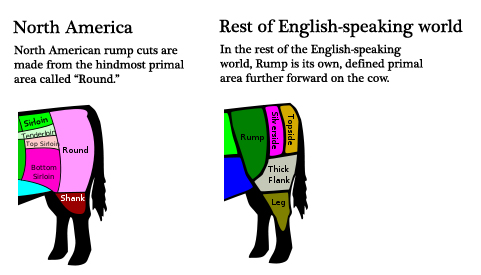How Long to Cook Rump Steak Medium to Well Done
What a rump steak is depends on where you are. North Americans have a completely different interpretation from the rest of the English-speaking world, and in France, it is completely different again, taken to higher levels of refinement.
When you are looking at recipes for rump steak, it's very important to suss out what audience the recipe is primarily addressed to. You can't cook a North American rump steak the way you would a British or New Zealand one, as they are actually two very different cuts despite the name being confusingly the same.

- 1 North American Rump Steak
- 2 British Rump Steak
- 3 French Rump Steak
- 4 Coeur de romsteck
- 5 Filet de romsteck
- 6 Pavé de romsteck
- 7 Language notes
North American Rump Steak
In North America, a rump steak starts off as a larger cut known as a rump roast of beef, from the round area of a cow — its hindmost area. This cut is boneless. (See main entry for "Beef round.") It will have next to no marbling or fat. This larger cut is then cut into smaller portions known as steaks.
You may sometimes see it labelled as a "butt steak", or as a generic "round steak."
It really does need slow, moist cooking such as braising, though with pounding and / or marinating you can transform it into something that can be pan-fried.
British Rump Steak
North Americans getting British-based advice about cooking a rump steak will be confused when they see people treating it as a grilling steak. That's because it is a completely different cut of beef. In Britain, Australia and New Zealand, a rump steak is cut from the area they call rump of a cow, which takes in the areas North American butchers call "sirloin", "tenderloin", "top sirloin", and "bottom sirloin", with none of the round at all. It will have good marbling. Though it is a cheaper cut than sirloin steaks, many chefs will still use it in their restaurants as they consider it to have superior flavour.
Here are some quotes reflecting the attitude of English foodies towards what are known as rump steaks in the UK:
"Rump steak is slightly cheaper than sirloin but it's still a great steak for griddling or frying, with more flavour than sirloin. However, it does tend to be slightly chewier, especially if it has not been matured properly." — Jason Atherton, former Gordon Ramsay chef. 2010. [1] Delicious Magazine, British edition. "How to cook the perfect steak." September 2010. Retrieved July 2011 from http://www.deliciousmagazine.co.uk/articles/how-to-cook-the-perfect-steak
"Rump is the other extreme. It's always moving backwards and forwards so there is a lot of muscle in there. The fat is in the meat so you have marbling. Rump always has the best flavour." — Tim Wilson, The Ginger Pig butchers in Levisham, North Yorkshire. 2008. [2] Morris, Sophie. "Fillet or sirloin, rump or ribeye, getting your beef in tip-top shape requires good ingredients, skill and a little alchemy." London: The Independent. 25 September 2008.
"I really love a thick piece of rump cut from a piece of beef that has been hung on the bone to mature for 21 days. Pan-fry it very quickly in a really hot pan to seal in the juices, then finish it off in the oven for about five to 10 minutes until it is medium-rare -– fantastic stuff! A really classy piece of rump has all the right ratios of fat, muscle structure, fibre and flavour." — John Torode, Smiths Restaurant, Smithfield Market, London. 2008. [3] Ibid.

Rump steak, Spain. pxfuel.com / CC0 1.0
French Rump Steak
In France there are three possible rump steaks, starting with one specifically cut as a steak.
Coeur de romsteck
In France, butchers start with a centre cut from the rump that they call the "coeur de romsteck", meaning "heart of the rump" steak. This can be used as a steak on its own, or further refined.
Filet de romsteck
The next step of refinement in a French rump steak is a "filet de romsteck" — "filet of rump steak". To make this cut, butchers take a "coeur de romsteck", and trim away all the fat and ligaments. What is left after that trimming is the "filet de romsteck."
A "filet de romsteck" will end up being a cylinder of meat about 30 cm (a foot) long that looks something like a tenderloin roast.
Pavé de romsteck
The third and final cut that can be made is called a "pavé de romsteck" — sort of meaning a "paving stone of rump steak", a "squat slab." It is the long "filet de romsteck" cut into individual serving-sized portions.
Language notes
The French word "romsteck" is an adaption of the English term "rump steak."

Frozen rump steaks, South Africa. Daniel Albany / Pixabay.com / 2017 / CC0 1.0
Other names
Italian: Cuore dello scamone
French: Bifteck de croupe, Filet de romsteck, Pavé de romsteck, Romsteck
German: Hauptstück vom Rumpsteak, RumpSteak
Spanish: Corazón de romsteck, Romsteck
This page first published: · Updated: .
This web site generates income from affiliated links and ads at no cost to you to fund continued research · Information on this site is Copyright © 2021· Feel free to cite correctly, but copying whole pages for your website is content theft and will be DCMA'd.
Tagged With: Beef Rump, Beef Steaks, French Food, Steak
How Long to Cook Rump Steak Medium to Well Done
Source: https://www.cooksinfo.com/rump-steak
0 Response to "How Long to Cook Rump Steak Medium to Well Done"
Post a Comment